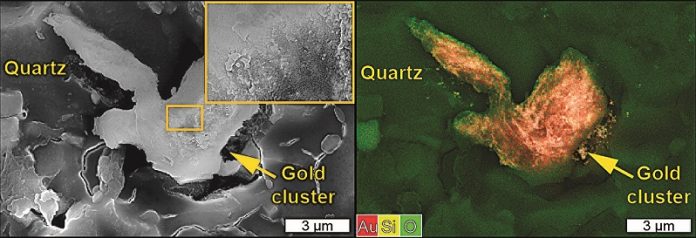
Scientists have long been intrigued by how large gold nuggets, often found in quartz veins, are formed.
New research from Monash University suggests that earthquakes might play a surprising role in creating these valuable nuggets.
Gold nuggets are highly prized for their rarity and beauty, sparking gold rushes throughout history.
Traditionally, scientists believed that gold forms when hot, water-rich fluids move through cracks in the Earth’s crust.
As these fluids cool or undergo chemical changes, the gold separates out and gets trapped in quartz veins.
While this explanation is widely accepted, it doesn’t fully account for the formation of large gold nuggets, especially since the concentration of gold in these fluids is very low.
Dr. Chris Voisey, a geologist at Monash University, and his team tested a new idea involving piezoelectricity. Piezoelectricity is a property of quartz, the mineral that usually hosts gold deposits.
When quartz is subjected to stress, it generates an electric charge. This is a phenomenon familiar to us from items like quartz watches and lighters, where a small force creates a significant voltage.
The team wondered if the stress from earthquakes could cause something similar to happen deep within the Earth.
To explore this, the researchers set up an experiment to mimic the conditions quartz might experience during an earthquake.
They placed quartz crystals in a fluid containing gold and applied stress using a motor to simulate the shaking of an earthquake. Afterward, they examined the quartz samples under a microscope to see if any gold had been deposited.
The results were remarkable. The stressed quartz not only deposited gold onto its surface but also formed tiny gold particles. Interestingly, the gold tended to accumulate on existing gold grains, building up over time rather than forming new grains from scratch.
This process happens because quartz is an electrical insulator, while gold is a conductor. Once some gold is deposited on the quartz, it becomes a point where more gold can collect, similar to how electroplating works.
Over time, as earthquakes continue to stress the quartz, more and more gold is deposited, eventually forming large nuggets.
Dr. Voisey explains that this discovery offers a new explanation for how large gold nuggets form in quartz veins.
The repeated stress from earthquakes creates piezoelectric voltages that help reduce dissolved gold from the surrounding fluid, causing it to deposit onto existing gold grains. This process could lead to the massive gold nuggets that have fascinated people for centuries.
This new understanding not only solves a geological mystery but also shows how interconnected Earth’s physical and chemical processes can be.



